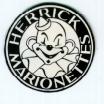The Herrick Collection - Page 3
The Herrick Marionettes
Memories by Ron Herrick (cont'd)

This is page 3 of the Memories of Ron Herrick from an audio tape recorded by Ron Herrick in 1983 and given to the Macdonald DeWitt Library Local History Collection.
That made ten shows that we had built. Of course, in the meantime, we had built quite a number of variety puppets. But our last show was Cinderella and when we were at the puppet festival in Miami Beach, Jane had found a group of hand puppets that were made by the Poppinjay puppeteers out in Cleveland. But there were two ugly sisters and Cinderella as a princess and poor little Cinderella. There was no wicked stepmother and the prince was a wimp. Oh, he was terrible. We bought those puppets and changed the heads. Well, we changed them into marionettes in the first place and we remodeled the prince to make him look like a square-jawed he-man and we modeled a wicked stepmother and the place where Cinderella and the Prince met was taken from the Vanderbilt house in Asheville. We had to buy-we couldn’t take pictures in there and when we were down to visit Ann and Dan we went to that house and we did buy a slide and when I came to paint that backdrop, I simply projected it up on the canvas that I was working on and charcoaled it in from that and painted it and at one place where we played, I think it was in Utica [New York]: a man came backstage afterward and said, “Wasn’t that scene from the Asheville Vanderbilt house?” We were quite please that he recognized it.
This was a difficult show to play but we finally made it work. We could not make the Prince and Cinderella dance together. But one of the nicest things about it was when Cinderella went offstage to get in the coach, the coach appeared in a window in the background and the horses appeared when the fairy godmother lit her wand and made things happen. She of course had a battery concealed inside her construction. And the horses appeared and Cinderella, in a smaller scale, got into the coach and drove off.
That was our 11th, no, that was our 9th show that we had built. In the meantime, we had built quite a number of clowns because I wanted an act that would be all clowns doing all variety of things. We had a clown that worked on a trapeze; we had another one that played the piano; we had another one that worked with several little chairs. It was all in pantomime trying one chair after another. He did not like them until he came to a big, soft, easy Morris-type chair. And we had quite a number of puppets that we had built in between shows.
In each of our shows we had effects or gimmicks such as in Rumple Stiltskin, when Rumple sat down to spin, we had a concealed motor that ran the spinning wheel. And then, at the proper time, the pile of straw turned into a pile of gold. That was done with an 8 or 10 inch Styrofoam ball, half of which was fixed up like straw and the other half with gold on it. And by pulling on a string, we could suddenly make the whole pile of straw turn into gold. Then in Rip Van Winkle, when Rip was telling Susan at the end about the little men bowling, up in the sky appeared a little bowler. We dimmed up a dimmer and here was a little Dutchman swinging and rolling a bowling ball. Then in Feathertop, when it opened, there was a little fireplace with, apparently, a fire burning in it. This was done with a cylinder inside of which there were a couple of light bulbs, yellow and red, and as it turned the perforations in the cylinder made it appear that the fireplace was burning. Then, when he found his rainbow, that was a prop that was setup behind the backdrop and shown through. Then, in Cinderella, when the fairy godmother turned the little mice into the coachman and the footman for Cinderella, those were things that made our stories distinctly ours.
In 1948 we joined Puppeteers of America. We had just found out about them from Joe and Mary Owens in Schenectady. And the first time that we attended a festival was in 1952 when it was held in Dartmouth. In 1958 I received the honor of being elected president of the P of A and that was in Chapel Hill, North Carolina. So I had the privilege of serving the P of A for a year as president.
Over the years we attended many puppet festivals all the way from UCLA to Dartmouth and from the University of Waterloo, Canada, down to Miami Beach, Florida, and in between. We went to Western College in Ohio, to Bowling Green, Ohio; to Detroit, to New York City, to Hurleyville. Oh, so many others I can’t begin to enumerate then all but we did go to a great many puppet festivals and over the years we played every show that we had ever done at one time or another in one of the national puppet festivals
We were accepted by our peers as being one of the top four or five puppet companies in the United State and that was very gratifying. The other puppeteers were the Proctors, Martin and Olga Stevens, the Roses and so forth and it was very nice to be in the company of such a distinguished group.
We had always said we were going to do puppets as long as it was fun and in 1978 the stairs started getting steeper and our equipment kept getting heavier and we decided it was time for us to hang up our puppets and retire. Just about that time Rick Morse from out in Detroit called us on the phone and asked if we had any shows for sale and we eventually sold him Rip Van Winkle for much less than we should have and sometime after that we received a phone call from Amy Vane asking if she could apprentice herself to us. We said “No, our shows were written for two-man manipulation and a third person would just be in the way.” But she and Chet did come to the house and when they found out that our business was for sale they said, “Would you sell it to us?” I got on the phone, got a hold of Rick and he said that his banker would not loan him the money to buy the business with and so we started talking with Chet and Amy. They eventually bought the business, the stage lights and the six shows and a year’s booking in advance. They lived in Stone Ridge just a few miles from us and we were teaching them how to play our shows because, even though Chet was in the original cast of Camelot on Broadway, and Amy was a graduate of UCLA and Mel Helstien’s special division of theater arts they still had to learn our shows.
It was nice having nine shows because we could play for nine years in a school before we had to repeat ourselves. We played every day that school was open. Some schools we played as many as 24 and 26 consecutive years. One school we went through three principals, all of the teaching staff and of course the kids had turned over quite a number of times.
To celebrate our retirement, we took a trip to Hawaii with Dan and Ann Fitch and when we came back we had no sleep that night because there was a big party on the plane and we came into Newark and drove up to Kingston and two things happened simultaneously, the phone rang and our neighbor Sharon Squire came in from across the street. Sharon said to Jane, “Have you heard the news?” When I answered the phone, Em Ackerman said, “Have you heard the news?” We both said, “No.” “Chet and Amy had a fire last night.” The equipment and the shows, all except Jack and the Beanstalk which was in their car and parked next to the house, were in their 150 year old barn and during the night that barn caught afire and Amy discovered it about 2 o’clock in the morning. It burned trees that were great big trees clear across the road. It burned the barn right down to the ground and we got -- tired as we were -- we got in the car and went out there and Amy put her head on Jane’s shoulder and wept and said, “They’re all gone. They’re all gone. They’re all gone.” Chet was walking around in shock with a face a mile long. We said, “We must have a few hours sleep. Come to the house for breakfast in the morning.” Which they did and we gave them a wooden stage which we had not quite completed. Of course they had the one show. They had been working on Dick Whittington and His Cat. That gave them another show and they made Rumple Stiltskin over again before the season started.
“They just called up their customers and said, “We were supposed to play such and such a play at your school. We’ve had a fire and that show has been destroyed. May we substitute so and so?” and the customers were all very good about it and said, “Yes, you may substitute.” We were heart sick to think that an entire life’s work had gone up in smoke and we were heart sick for those two guys who had brought our shows but they stuck at it and, so far as I know they’re still playing the Herrick marionettes up and down the Hudson Valley.
We played every day that school was open and one typical year we figured up that we had played for 240 separate customers. Our puppets were very good to us. They bought us a lovely house on Shady Lane. Each year they bought us a new station wagon. They took us to Europe three times and to Hawaii once. They took us all over the United States and to various puppet festivals. In other words, the Herrick marionettes were a success. And on thinking it over I think I know why. Whether we were designing puppets, writing scripts, whatever we did, we strove for perfection. We didn’t always reach perfection but within limits of our talents, we tried our very best.
This is Ron Herrick, signing off, August 8th, 1983. Thank you for listening.
©1983 Ron Herrick & Macdonald DeWitt Library




